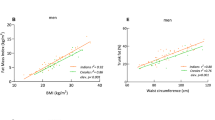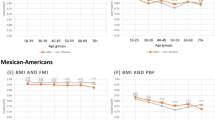Abstract
Background
To examine the associations of total and regional adiposity with metabolic and cardiovascular disease (CVD) risk markers.
Methods
This cross-sectional study included 1080 (53.8% men, aged 39–44 years) individuals from South India. Anthropometry (height, weight, waist and hip circumference), body composition assessment using dual-energy X-ray absorptiometry (DXA), blood pressure (BP), and plasma glucose, insulin and lipids were measured. Regression analysis was used to examine associations of standardized fat measurements with type 2 diabetes (T2D), insulin resistance (IR), hypertension and hypertriglyceridemia and continuous measurements of BP, glucose, insulin, HOMA-IR and lipids. Contour plots were constructed to visualize the differential effect of upper and lower fat depots.
Results
DXA-measured fat depots were positively associated with metabolic and CVD risk markers. After adjusting for fat mass index, upper body fat remained positively, while lower body fat was negatively associated with risk markers. A one standard deviation (SD) increase in android fat showed higher odds ratios (ORs) for T2D (6.59; 95% CI 3.17, 13.70), IR (4.68; 95% CI 2.31, 9.50), hypertension (2.57; 95% CI 1.56, 4.25) and hypertriglyceridemia (6.39; 95% CI 3.46, 11.90) in men. A 1 SD increase in leg fat showed a protective effect with ORs for T2D (0.42; 95% CI 0.24, 0.74), IR (0.31; 95% CI 0.17, 0.57) and hypertriglyceridemia (0.61; 95% CI 0.38, 0.98). The magnitude of the effect was greater with DXA-measured fat compared with anthropometry.
Conclusion
At any level of total body fat, upper and lower body fat depots demonstrate opposite risk associations with metabolic and CVD risk markers in Asian Indians.
This is a preview of subscription content, access via your institution
Access options
Subscribe to this journal
Receive 12 print issues and online access
$259.00 per year
only $21.58 per issue
Buy this article
- Purchase on Springer Link
- Instant access to full article PDF
Prices may be subject to local taxes which are calculated during checkout


Similar content being viewed by others
Data availability
The data underlying this article will be shared on reasonable request to the corresponding author.
References
Haldar S, Chia SC, Henry CJ. Body composition in Asians and Caucasians: comparative analyses and influences on cardiometabolic outcomes. Adv Food Nutr Res. 2015;75:97–154.
Norgan NG. Population differences in body composition in relation to the body mass index. Eur J Clin Nutr. 1994;48:S10–25.
Lear SA, Kohli S, Bondy GP, Tchernof A, Sniderman AD. Ethnic variation in fat and lean body mass and the association with insulin resistance. J Clin Endocrinol Metab. 2009;94:4696–702.
Deurenberg-Yap M, Schmidt G, van Staveren WA, Deurenberg P. The paradox of low body mass index and high body fat percentage among Chinese, Malays and Indians in Singapore. Int J Obes. 2000;24:1011–7.
Zong G, Zhang Z, Yang Q, Wu H, Hu FB, Sun Q. Total and regional adiposity measured by dual‐energy X‐ray absorptiometry and mortality in NHANES 1999‐2006. Obesity. 2016;24:2414–21.
Després JP, Lemieux I. Abdominal obesity and metabolic syndrome. Nature. 2006;444:881–7.
Manolopoulos KN, Karpe F, Frayn KN. Gluteofemoral body fat as a determinant of metabolic health. Int J Obes. 2010;34:949–59.
Karpe F, Pinnick KE. Biology of upper-body and lower-body adipose tissue—link to whole-body phenotypes. Nat Rev Endocrinol. 2015;11:90.
Jensen MD. Role of body fat distribution and the metabolic complications of obesity. The J Clin Endocrinol Metab. 2008;93:s57–63.
Wiklund P, Toss F, Weinehall L, Hallmans G, Franks PW, Nordstrom A, et al. Abdominal and gynoid fat mass are associated with cardiovascular risk factors in men and women. J Clin Endocrinol Metab. 2008;93:4360–6.
Vasan SK, Osmond C, Canoy D, Christodoulides C, Neville MJ, Di Gravio C, et al. Comparison of regional fat measurements by dual-energy X-ray absorptiometry and conventional anthropometry and their association with markers of diabetes and cardiovascular disease risk. Int J Obes. 2018;42:850–7.
Van Pelt RE, Evans EM, Schechtman KB, Ehsani AA, Kohrt WM. Contributions of total and regional fat mass to risk for cardiovascular disease in older women. Am J Physiol Endocrinol Metab. 2002;282:E1023–8.
Banerji MA, Faridi N, Atluri R, Chaiken RL, Lebovitz HE. Body composition, visceral fat, leptin, and insulin resistance in Asian Indian men. J Clin Endocrinol Metab. 1999;84:137–44.
Raji A, Seely EW, Arky RA, Simonson DC. Body fat distribution and insulin resistance in healthy Asian Indians and Caucasians. J Clin Endocrinol Metab. 2001;86:5366–71.
Antonisamy B, Raghupathy P, Christopher S, Richard J, Rao PS, Barker DJ, et al. Cohort profile: the 1969–73 Vellore birth cohort study in South India. Int J Epidemiol. 2009;38:663–9.
Raghupathy P, Antonisamy B, Geethanjali FS, Saperia J, Leary SD, Priya G, et al. Glucose tolerance, insulin resistance and insulin secretion in young south Indian adults: Relationships to parental size, neonatal size and childhood body mass index. Diabetes Res Clin Pract. 2010;87:283–92.
Alberti KG, Zimmet PZ. Definition, diagnosis and classification of diabetes mellitus and its complications. Part 1: diagnosis and classification of diabetes mellitus. Provisional report of a WHO consultation. Diabet Med. 1998;15:539–53.
Whelton PK, Carey RM, Aronow WS, Casey DE Jr, Collins KJ, Dennison Himmelfarb C, et al. 2017 ACC/AHA/AAPA/ABC/ACPM/AGS/APhA/ASH/ASPC/NMA/PCNA guideline for the prevention, detection, evaluation, and management of high blood pressure in adults: a report of the American College of Cardiology/American Heart Association Task Force on Clinical Practice Guidelines. Jm Coll Cardiol. 2018;71:e127–248.
Expert Panel on Detection E. Executive summary of the third report of the National Cholesterol Education Program (NCEP) expert panel on detection, evaluation, and treatment of high blood cholesterol in adults (Adult Treatment Panel III). JAMA. 2001;285:2486–97.
Riani M, Zani S. Generalized distance measures for asymmetric multivariate distributions. Advances in Data Science and Classification. Studies in Classification, Data Analysis, and Knowledge Organization. Heidelberg: Springer-Berlin; 1998.
Aasen G, Fagertun H, Halse J. Regional fat mass by DXA: high leg fat mass attenuates the relative risk of insulin resistance and dyslipidaemia in obese but not in overweight postmenopausal women. Scand J Clin Lab Invest. 2008;68:204–11.
Fu X, Song A, Zhou Y, Ma X, Jiao J, Yang M, et al. Association of regional body fat with metabolic risks in Chinese women. Public Health Nutr. 2014;17:2316–24.
Snijder MB, Zimmet PZ, Visser M, Dekker JM, Seidell JC, Shaw JE. Independent and opposite associations of waist and hip circumferences with diabetes, hypertension and dyslipidemia: the AusDiab Study. Int J Obes. 2004;28:402–9.
Lear SA, Humphries KH, Kohli S, Birmingham CL. The use of BMI and waist circumference as surrogates of body fat differs by ethnicity. Obesity. 2007;15:2817–24.
Ramachandran A, Snehalatha C, Dharmaraj D, Viswanathan M. Prevalence of glucose intolerance in Asian Indians: urban-rural difference and significance of upper body adiposity. Diabetes Care. 1992;15:1348–55.
Nielsen S, Guo Z, Johnson CM, Hensrud DD, Jensen MD. Splanchnic lipolysis in human obesity. J Clin Invest. 2004;113:1582–8.
Goel K, Misra A, Vikram NK, Poddar P, Gupta N. Subcutaneous abdominal adipose tissue is associated with the metabolic syndrome in Asian Indians independent of intra-abdominal and total body fat. Heart. 2010;96:579–83.
Porter SA, Massaro JM, Hoffmann U, Vasan RS, O’Donnel CJ, Fox CS. Abdominal subcutaneous adipose tissue: a protective fat depot? Diabetes Care. 2009;32:1068–75.
McLaughlin T, Lamendola C, Liu A, Abbasi F. Preferential fat deposition in subcutaneous versus visceral depots is associated with insulin sensitivity. J Clin Endocrinol Metab. 2011;96:E1756–60.
Marinou K, Hodson L, Vasan SK, Fielding BA, Banerjee R, Brismar K, et al. Structural and functional properties of deep abdominal subcutaneous adipose tissue explain its association with insulin resistance and cardiovascular risk in men. Diabetes Care. 2014;37:821–9.
Snijder MB, Visser M, Dekker JM, Goodpaster BH, Harris TB, Kritchevsky SB, et al. Low subcutaneous thigh fat is a risk factor for unfavourable glucose and lipid levels, independently of high abdominal fat. The Health ABC Study. Diabetologia. 2005;48:301–8.
Yusuf S, Hawken S, Ounpuu S, Bautista L, Franzosi MG, Commerford P, et al. Obesity and the risk of myocardial infarction in 27 000 participants from 52 countries: a case-control study. The Lancet. 2005;366:1640–9.
Choi SI, Chung D, Lim JS, Lee MY, Shin JY, Chung CH, et al. Relationship between regional body fat distribution and diabetes mellitus: 2008 to 2010 Korean National Health and Nutrition Examination Surveys. Diabetes Metab J. 2017;41:51.
Wiklund P, Toss F, Jansson JH, Eliasson M, Hallmans G, Nordström A, et al. Abdominal and gynoid adipose distribution and incident myocardial infarction in women and men. Int J Obes. 2010;34:1752–8.
Tankó LB, Bagger YZ, Alexandersen P, Larsen PJ, Christiansen C. Central and peripheral fat mass have contrasting effect on the progression of aortic calcification in postmenopausal women. Eur Heart J. 2003;24:1531–7.
Okura T, Nakata Y, Yamabuki K, Tanaka K. Regional body composition changes exhibit opposing effects on coronary heart disease risk factors. Arterioscler Thromb Vasc Biol. 2004;24:923–9.
Lemieux I. Energy partitioning in gluteal-femoral fat: does the metabolic fate of triglycerides affect coronary heart disease risk? Arterioscler Thromb Vasc Biol. 2004;24:795–7.
Frayn K. Adipose tissue as a buffer for daily lipid flux. Diabetologia. 2002;45:1201–10.
Neeland IJ, Turer AT, Ayers CR, Berry JD, Rohatgi A, Das SR, et al. Body fat distribution and incident cardiovascular disease in obese adults. J Am Coll Cardiol. 2015;65:2150–1.
Knowles R, Carter J, Jebb SA, Bennett D, Lewington S, Piernas C. Associations of Skeletal Muscle Mass and Fat Mass With Incident Cardiovascular Disease and All-Cause Mortality: A Prospective Cohort Study of UK Biobank Participants. J Am Heart Assoc. 2021;10:e019337.
Shishikura K, Tanimoto K, Sakai S, Tanimoto Y, Terasaki J, Hanafusa T. Association between skeletal muscle mass and insulin secretion in patients with type 2 diabetes mellitus. Endocr J. 2014;61:281–7.
Lee DH, Keum N, Hu FB, Orav EJ, Rimm EB, Willett WC, et al. Predicted lean body mass, fat mass, and all cause and cause specific mortality in men: prospective US cohort study. BMJ. 2018;362:k2575.
Acknowledgements
The authors would like to thank all the participants, fieldworkers, collaborators and supporting staff who have worked on this project.
Funding
The study was partly funded by internal research grants from the Christian Medical College, Vellore (IRB 8920/05-2014), Indian Institute of Public Health, India (WTP Project grant/09-2012). Vellore Birth Cohort adult follow-up was supported by the British Heart Foundation (BHF_RG/98001 and BHF_CS/15/4/31493).
Author information
Authors and Affiliations
Contributions
MSG, BA, FK, CHDF, CO and SKV provided substantial contribution to conception and design, acquisition of data, or analysis and interpretation of data. FSG, NT, FJ and TVP were involved in the acquisition of data. MGS and SKV drafted the first version of the manuscript. All authors were involved in the revision of the manuscript and approved the final version to be published. MSG and SKV are accountable for all aspects of the work and the accuracy and integrity of the data.
Corresponding authors
Ethics declarations
Competing interests
The authors declare no competing interests.
Ethics approval
This study was approved by the institutional review board of the Christian Medical College and Hospital, Vellore and all participants provided informed consent.
Additional information
Publisher’s note Springer Nature remains neutral with regard to jurisdictional claims in published maps and institutional affiliations.
Supplementary information
Rights and permissions
About this article
Cite this article
Gowri S, M., Antonisamy, B., Geethanjali, F.S. et al. Distinct opposing associations of upper and lower body fat depots with metabolic and cardiovascular disease risk markers. Int J Obes 45, 2490–2498 (2021). https://doi.org/10.1038/s41366-021-00923-1
Received:
Revised:
Accepted:
Published:
Issue Date:
DOI: https://doi.org/10.1038/s41366-021-00923-1
This article is cited by
-
Visceral-to-peripheral adiposity ratio: a critical determinant of sex and ethnic differences in cardiovascular risks among Asian Indians and African Creoles in Mauritius
International Journal of Obesity (2024)
-
Body composition predicts hypertension using machine learning methods: a cohort study
Scientific Reports (2023)
-
It Is Not Just Fat: Dissecting the Heterogeneity of Adipose Tissue Function
Current Diabetes Reports (2022)



